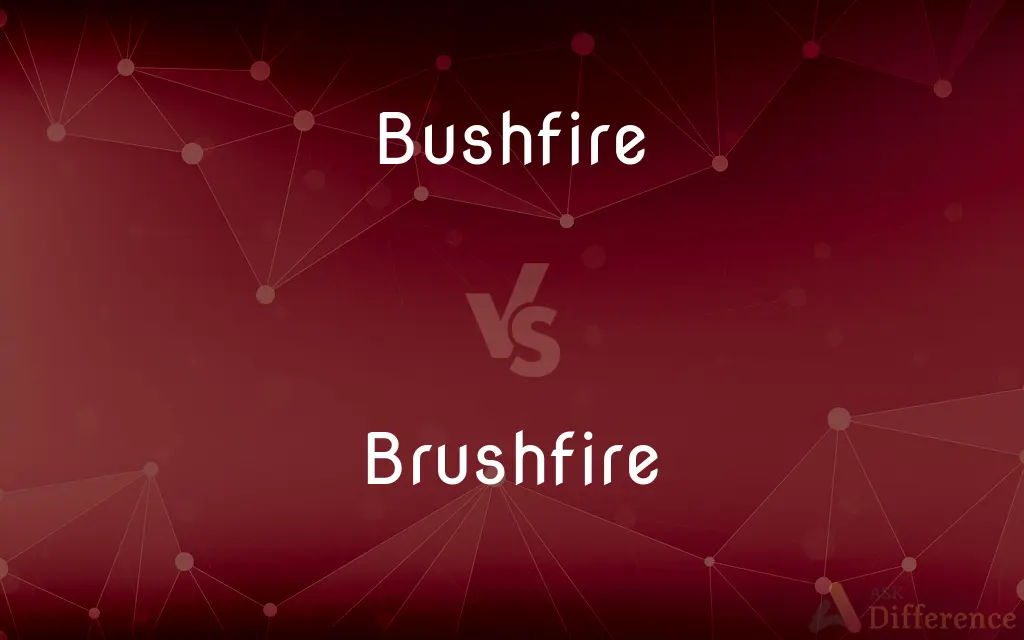Bushfire vs. Brushfire — What's the Difference?
By Maham Liaqat & Urooj Arif — Updated on March 28, 2024
Bushfires are large-scale wildfires in Australia's bushland, while brushfires are smaller, localized fires in dense underbrush or vegetation areas, often in the US.

Difference Between Bushfire and Brushfire
Table of Contents
ADVERTISEMENT
Key Differences
Bushfires and brushfires both involve the uncontrolled burning of vegetation, but they differ in scale, location, and the types of vegetation involved. Bushfires, a term commonly used in Australia, refer to wildfires that occur in the bushland—vast, undeveloped areas covered in native vegetation. On the other hand, brushfires are generally smaller and occur in areas of dense underbrush or scrub vegetation, typically in the United States. While they can quickly spread and cause damage, brushfires are often more localized than bushfires. The term "brushfire" highlights the primary fuel for these fires: the brush or scrub vegetation, which can ignite easily under the right conditions.
The management strategies for bushfires and brushfires also differ due to their scale and the environments in which they occur. Bushfire management might include large-scale controlled burns, extensive firefighting efforts, and community-wide evacuation plans. Brushfire management, while also including firefighting and controlled burns, often focuses on clearing brush and creating defensible spaces around properties to reduce fire risk.
Both types of fires can have devastating environmental impacts, leading to loss of vegetation, wildlife habitat, and biodiversity. However, they also play a natural role in some ecosystems, helping to clear old and dead vegetation, stimulating new growth, and maintaining ecological balance.
The distinction between bushfires and brushfires underscores the importance of regional terminology and the specific environmental contexts in which these fires occur. Understanding these differences is crucial for effective fire management and prevention strategies in vulnerable regions.
Comparison Chart
Scale
Large-scale, can cover vast areas.
Generally smaller, more localized.
ADVERTISEMENT
Location
Commonly occurs in Australia's bushland.
Often occurs in the US in areas with dense underbrush.
Vegetation
Involves native bushland vegetation.
Involves brush or scrub vegetation.
Management
Includes controlled burns, firefighting, and evacuations.
Focuses on clearing brush and creating defensible spaces.
Environmental Role
Can stimulate new growth, clear dead vegetation.
Similar ecological role, but on a smaller scale.
Compare with Definitions
Bushfire
Affects large areas.
Bushfires can spread across thousands of hectares.
Brushfire
Can spread rapidly.
Dry conditions can cause a brushfire to spread quickly.
Bushfire
Natural ecological role.
Some plant species rely on bushfires for seed germination.
Brushfire
Fire in dense underbrush.
A brushfire near the town was quickly contained.
Bushfire
Threatens wildlife and property.
Bushfires pose a significant risk to endangered species.
Brushfire
More localized fire.
Brushfires can threaten homes but are usually smaller in scale.
Bushfire
Wildfire in Australian bushland.
The 2019-2020 bushfires in Australia were devastating.
Brushfire
Managed by clearing brush.
Homeowners can reduce brushfire risk by clearing vegetation.
Bushfire
Managed with controlled burns.
Controlled burns are a key strategy in bushfire management.
Brushfire
Plays a role in ecosystem.
Brushfires also help clear dead vegetation and stimulate growth.
Bushfire
(Australia) An uncontrolled fire in a wooded or grassy area; a wildfire.
Brushfire
A fire in low-growing, scrubby trees and brush.
Brushfire
A relatively minor crisis.
Brushfire
Minor enough to involve only small-scale mobilization of counteracting resources
Brushfire wars.
Brushfire
A large fire in a scrubland or prairie, as opposed to a forest fire, which happens in forests.
Brushfire
A war that does not directly involve the world's superpowers.
Common Curiosities
What causes bushfires and brushfires?
Both can be sparked by natural causes like lightning or human activities such as arson and unattended campfires.
What are the main differences in management strategies?
Bushfire management often requires large-scale efforts and community-wide plans, while brushfire management focuses on local clearing and property protection.
How do weather conditions affect these fires?
Hot, dry, and windy conditions can exacerbate both bushfires and brushfires, increasing their intensity and spread.
How can individuals prepare for these fires?
By maintaining defensible spaces, adhering to local fire regulations, and having evacuation plans in place.
Are bushfires more dangerous than brushfires?
While both can be destructive, bushfires tend to cover larger areas and can be more difficult to control, potentially posing greater risks.
Can bushfires and brushfires be beneficial?
Yes, in certain ecosystems, they help maintain ecological balance by clearing dead vegetation and stimulating new growth.
How do these fires impact wildlife?
They can destroy habitats, but some species have adapted to survive or benefit from the aftermath of fires.
Can climate change affect bushfires and brushfires?
Yes, climate change can increase the frequency and intensity of these fires by creating hotter, drier conditions.
What role do humans play in these fires?
Human activities can both cause and exacerbate fires, but responsible management and practices can mitigate risks.
What is the significance of controlled burns?
Controlled burns are a preventative measure to reduce fuel load and decrease the severity of potential fires.
How are communities affected by bushfires and brushfires?
They can face evacuation, loss of property, and in severe cases, loss of life, emphasizing the need for preparedness and resilience.
How do firefighters combat these fires?
Through a combination of ground and aerial efforts, creating firebreaks, and strategic use of water and retardants.
How do recovery efforts differ between bushfires and brushfires?
Recovery can be more extensive for bushfires due to their scale, but both require efforts to restore ecosystems and rebuild communities.
What is the impact on air quality?
Smoke from these fires can significantly reduce air quality, posing health risks to humans and animals.
Can bushfires and brushfires be predicted?
While specific outbreaks are difficult to predict, risk levels can be assessed based on weather conditions and vegetation dryness.
Share Your Discovery

Previous Comparison
Found vs. Fount
Next Comparison
Persistor vs. PersisterAuthor Spotlight
Written by
Maham LiaqatCo-written by
Urooj ArifUrooj is a skilled content writer at Ask Difference, known for her exceptional ability to simplify complex topics into engaging and informative content. With a passion for research and a flair for clear, concise writing, she consistently delivers articles that resonate with our diverse audience.















































